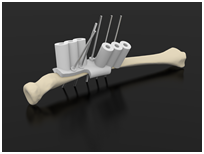 The patient, a 15-year-old boy, experienced problems with supination, in addition to a lack of pronation after conservative treatment of a double radius fracture. Thanks to Materialise's surgery planning and guide design services, surgery time decreased from 3 hours to 45 minutes.
The patient, a 15-year-old boy, experienced problems with supination, in addition to a lack of pronation after conservative treatment of a double radius fracture. Thanks to Materialise's surgery planning and guide design services, surgery time decreased from 3 hours to 45 minutes.
In September 2007, a 15-year-old boy entered an emergency room in Oslo suffering from a double-radius fracture. He was treated for his injury but unfortunately, the boy experienced problems pronating and supinating after the fracture healed. This made it impossible for him to continue one of his favorite hobbies: playing guitar. An X-ray, taken in February 2008 (Fig 1), indicated that a malunion of the radius was at fault, a problem which can be quite complex to repair. Fortunately, the surgeons in this case, Dr. Filip Stockmans and Dr. Torstein Husby, opted to use virtual surgical planning and patient-specific surgical guides from Materialise in the treatment of their patient; helping them repair his arm and put the music back in his life.
 Interactive, computer-assisted surgical planning
Interactive, computer-assisted surgical planning
Thanks to the 3D image data, it was possible to see how serious the malunion actually was. Armed with this information, Dr. Stockmans and Dr. Husby collaborated with their personal engineer at Materialise in order to try out a variety of different surgical plans prior to surgery. In this way, they were able to choose the best possible treatment for this specific case and turn it into a virtual surgical plan, ready for the next step of the process.
Patient-specific surgical guides put pre-surgical plan into action
Based on the surgical plan, the surgeons' personal engineer at Materialise began the design of patient-specific surgical guides. These surgical guides were built to fit the unique shape of the patient's bone and were fitted with drill sleeves and slits to perform the osteotomies determined in the pre-surgical plan. Once the guides were approved by the surgeons, there were brought to life at Materialise using Additive Manufacturing. Then, with the pre-surgical plan and guides in hand, the surgeons were able to confidently step into the operating room and realize the results they set out to achieve.
A Successful Outcome is Music to our Ears
The 15-year-old boy, who is happily playing his guitar again, is just one example of how 3D virtual surgical planning and the use of patient-specific guides can make complex procedures easier to handle. This technology opens up a new world of possibilities in orthopaedics and as more surgeons discover its benefits, they are able to pass on the advantages to an increasing number of patients; helping materialise a better and healthier world.
Filip Stockmans, MD, is a professor at the Katholieke Universiteit Leuven, Campus Kortrijk Belgium. Trained in Hand & Microsurgery at the Kleinert Institute in Louisville, Kentucky and University of Umea in Sweden, Dr. Stockmans has been in private practice for over 20 years.
Torstein Husby, MD, PhD, is a senior consultant at Oslo University Hospital, Norway, dealing with hand and upper extremity surgery. Dr. Husby is trained at the the National Hospital of Norway, section for Hand and Microsurgery, and has been working with orthopaedic surgery since 1983, limited to upper extremity surgery for 22 years.
www.materialise.com
























































































